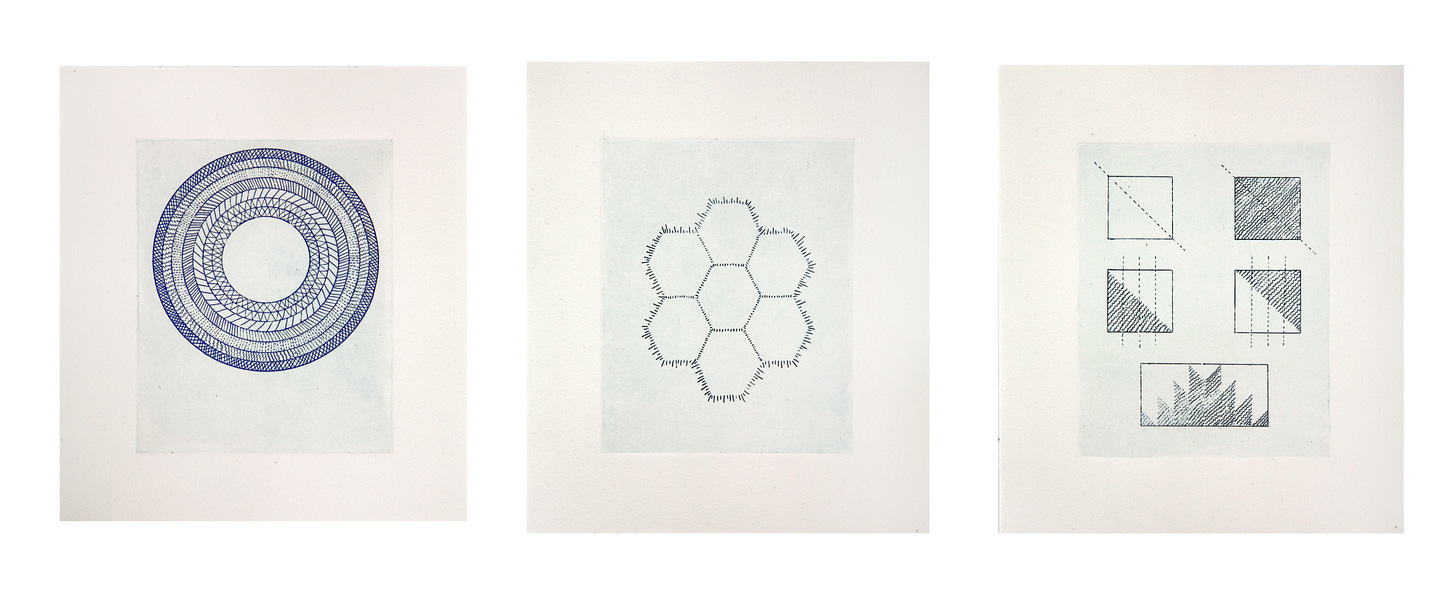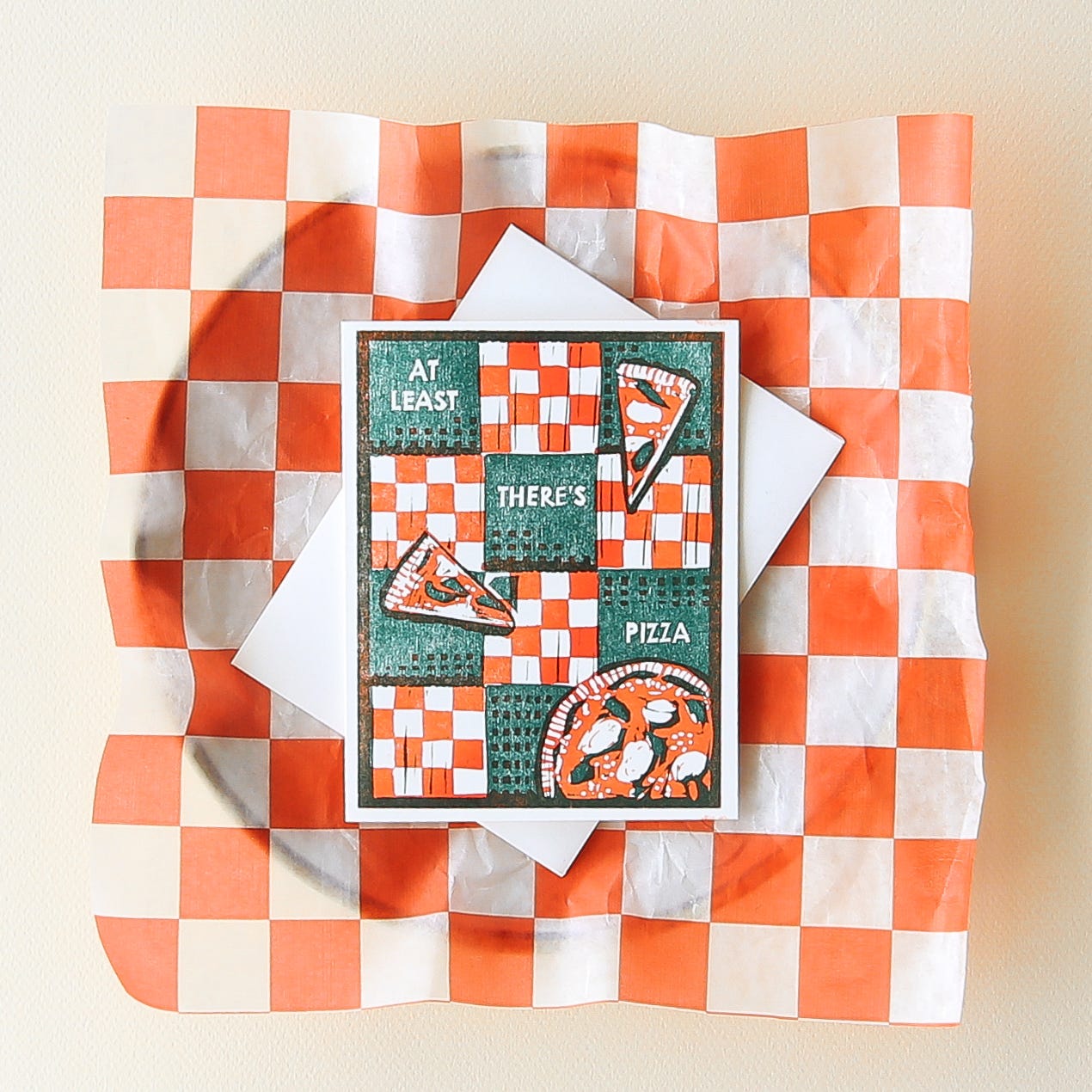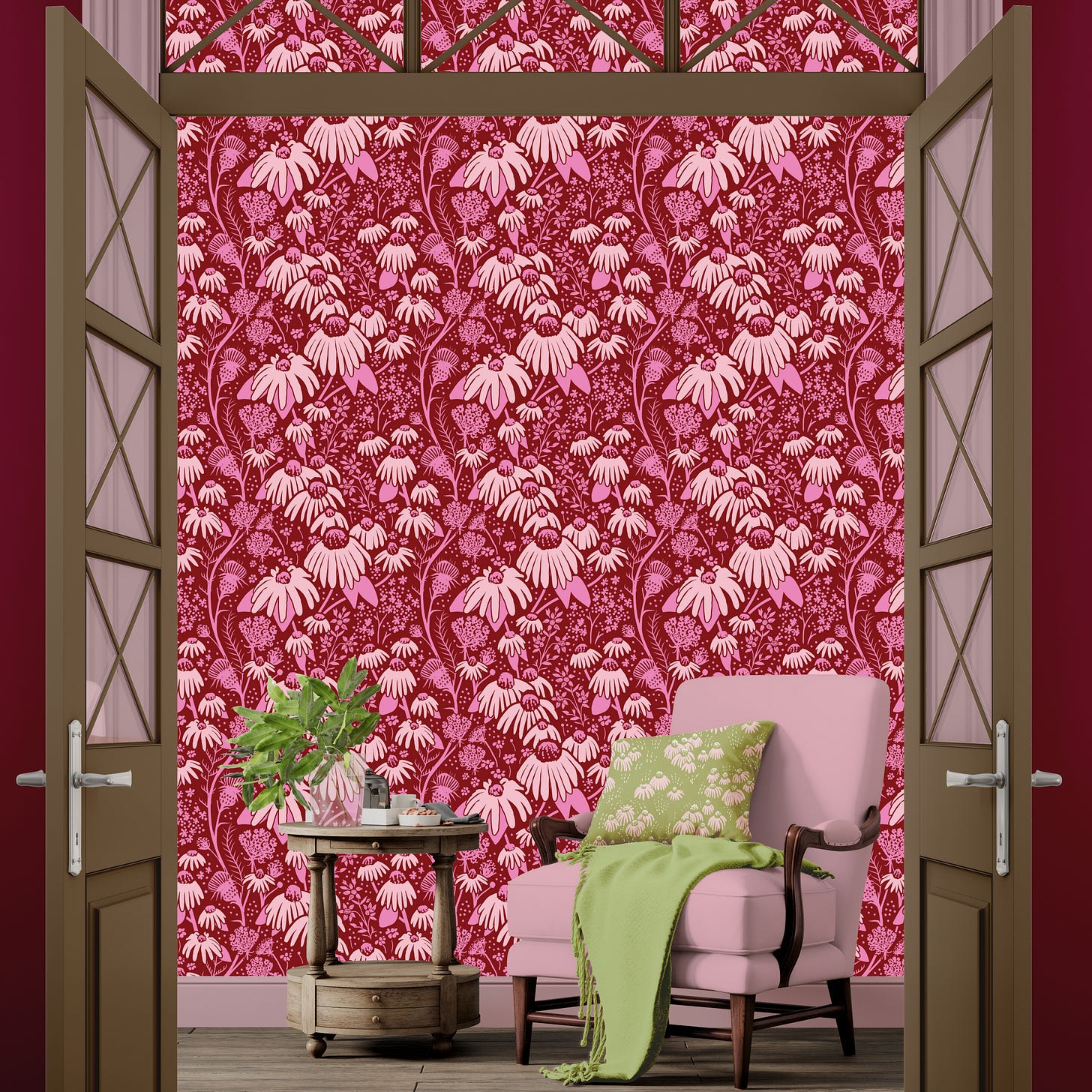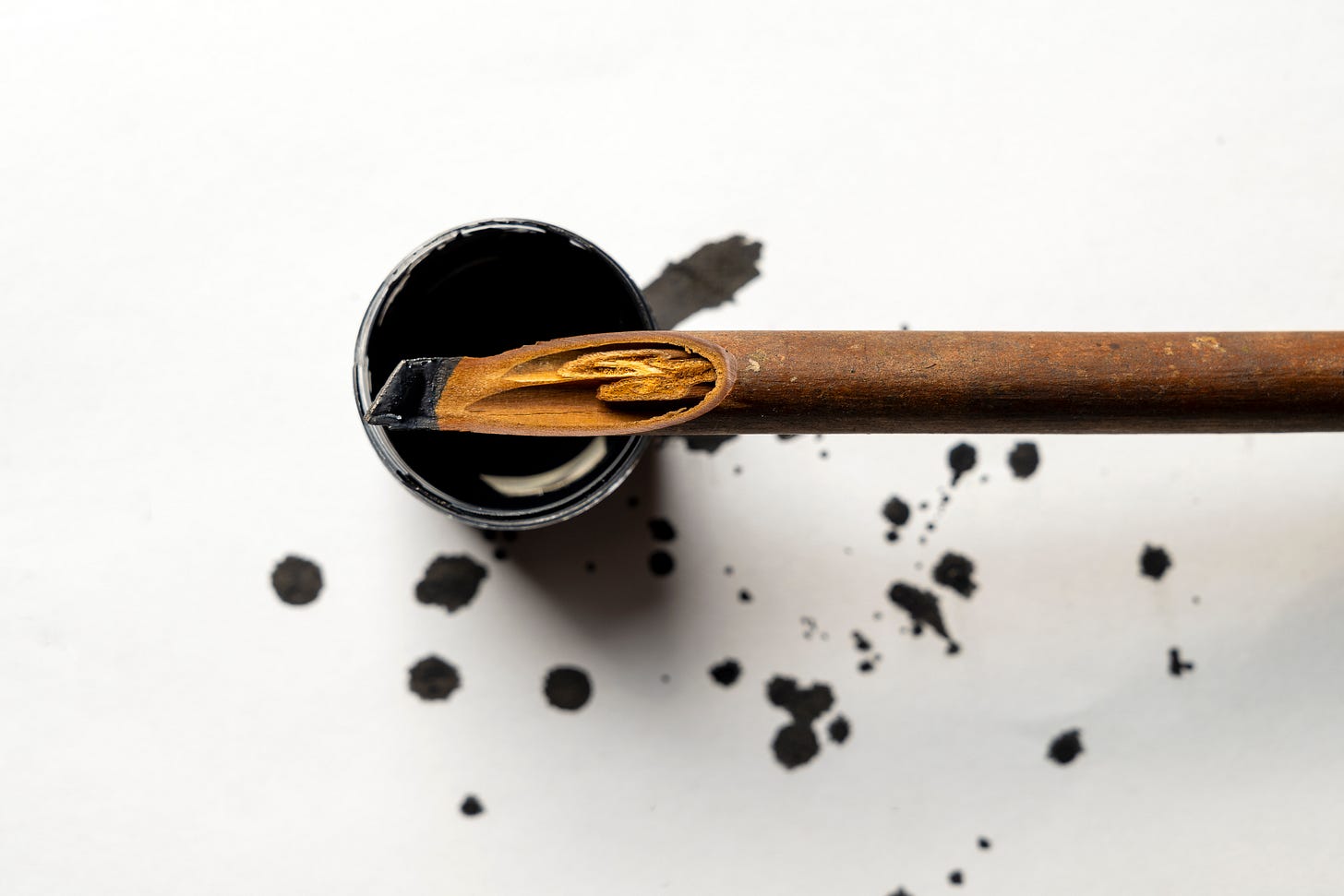Our newest assorted boxed set of patterned letterpress greeting cards for Heartell Press will be released later this month: Summer Blooms! So today, to celebrate, I want to share with you some of the story and process behind these new designs.
The word pattern can mean a lot of things; I’m defining it here as a design that can seamlessly repeat. There are lots of ways a design can repeat, but in a successful pattern the seams will be hard to see. The goal is to create a design that guides the eye to wander through the pattern freely without getting stuck on unintentional “rivers” or lines interrupting the flow.
A Pattern Emerges
Long before I knew what surface design was, or that one could pursue it as a career, I’ve loved patterns. My mom loved to sew and some of my earliest memories are of playing dress-up with remnants and making doll clothes out of scraps. I can clearly remember the navy blue floral wallpaper in our kitchen and the Marimekko sheets on my parents’ bed and the feeling of home that it gave me to run my fingers over them. I love the idea of creating new designs that can become a part of others’ memories and relationships.
In grad school at the School of the Art Institute in Chicago, I explored ideas about how pattern plays a role in memory and helps create a framework for our emotions. I made etchings of quilt patterns, watercolor paintings of patchwork and even a “floor quilt” made out of linoleum that I laser cut into a quilt pattern (we had a dance party on it at the opening).
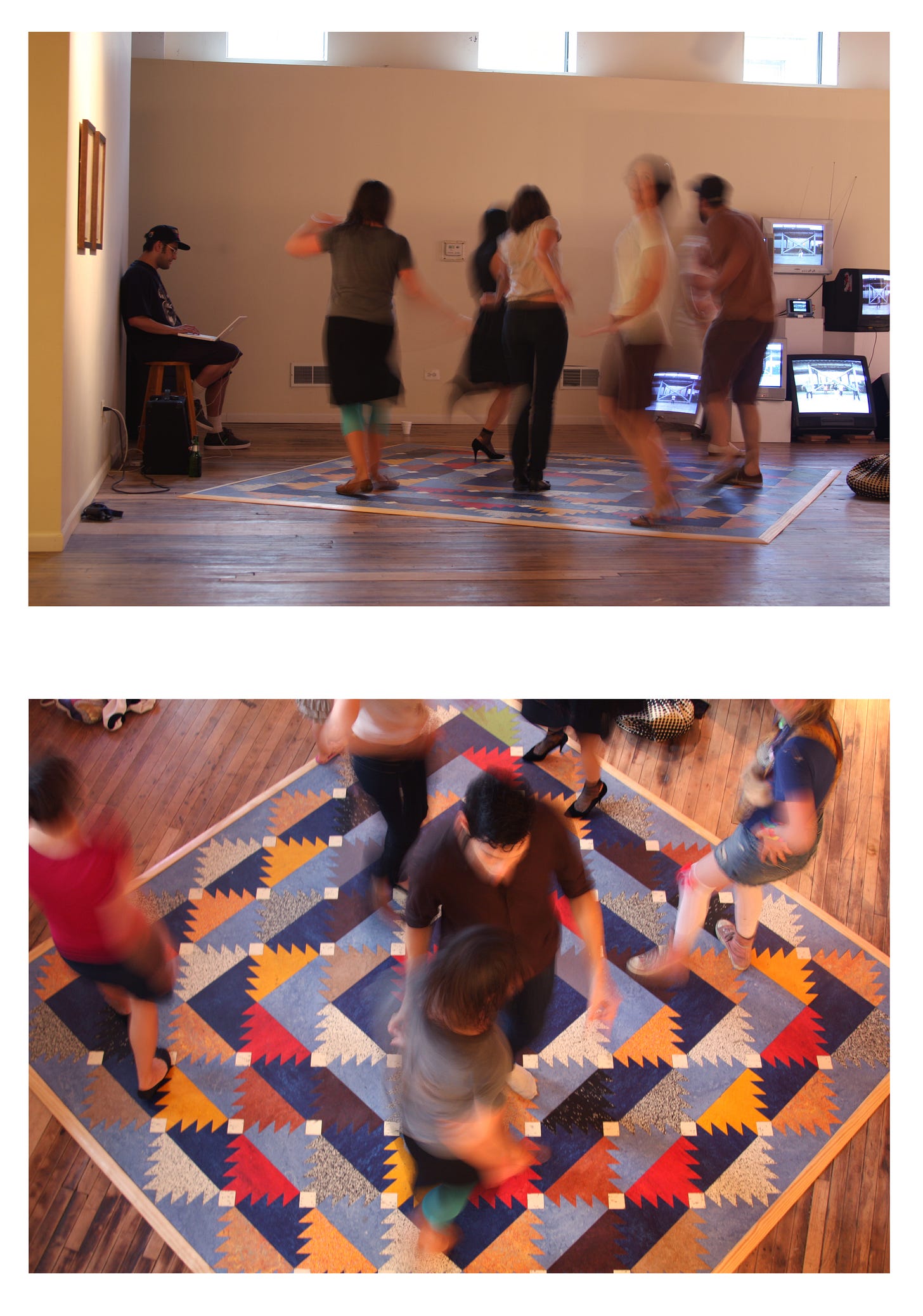
SAIC was centered around conceptual art, and even though I enjoyed the process of making objects whose main purpose was to express ideas, I felt a pull toward visual work that was more woven in with the necessities of life and connected to the traditions of my forebears. The tension in academic art programs and institutions between “Art” and “craft” is less taut now I think, but at the time I experienced it as a longing to make something my Grammie could relate to. I wanted to make objects that would give me the sense that I had a purpose in the community beyond provoking thoughts or feelings in a sterile gallery setting.
Back in the Gap: Learning a New Skill
Long story short: over the next decade or so, I created a job for myself designing greeting cards by founding Heartell Press. By 2022, I had designed over 300 greeting cards and was hungry for a new challenge. I’d also had two kids and lost my mom, and my impulse to express something meaningful about the cyclical patterns that govern our lives had taken on a new sense of urgency. Light and dark, cold and warmth, life and death; again and again and again.
I had been eyeing Bonnie Christine’s Surface Pattern Design Immersion course for a while, but in 2022 her brilliant marketing caught me at the right time and I decided to take the plunge and sign up. I didn’t really have time but somehow between greeting card releases and weekly newsletters and nursing my baby and chasing my toddler I managed to complete the eight weeks of online learning and practice and figured out how to make seamlessly repeating vector patterns in Adobe Illustrator. There is math involved and it wasn’t an easy skill for me to pick up but I did eventually get the hang of it. I also met some other wonderful pattern designers with whom I still meet and compare notes whenever we can.
Once I figured out the basic mechanics of it, the really hard part started. I suddenly found myself deep in what Ira Glass calls “the gap.” I had been making art in a serious, consistent way for almost twenty years by then, and making a living from it for almost a decade. I had always had plenty of ideas, but after years and years of practice, I had finally arrived at a point in my career and my practice where I could usually count on being able to wrestle a workable, useful version of any given idea which I could then put on a card or print or other product and then sell. But with patterns, I was using a whole new visual language, and my early patterns were GARBAGE.
I’d made cards that had repeating patterns as elements (wallpaper, a tablecloth, a dress), but they were always ”implied” (a.k.a fake) repeats and would not have worked as a true seamless repeat if you tried to make a tile from them. The trickiest part has been to train myself to think in terms of motifs instead of layers. When I create a woodblock design for a greeting card, I’m carving the image out of a solid field of color, and the negative space is often the focus of the image. Motifs for patterns are usually undulating, irregularly shaped things that can be turned and moved and fitted together like a puzzle, hiding the seams. My blocks are relentlessly rectangular, which made it tricky to use scans of them to create repeating patterns.

I tried carving new motifs out of rubber stamps and had a little more success with that. I also started to get a better feel for what kind of repeats I like and added more skills to my repertoire. I learned to make a half-drop pattern (where the design lines up vertically, but shifts over and drops down by half the height of the repeat as it moves across the surface) from this awesome class on Skillshare by Carrie Cantwell and things started to come together a little more.
Applying My New Skill
At this point I’d been making repeating patterns for about a year. I started doing the weekly design challenges created by the print-on-demand fabric company Spoonflower. Having to respond to a brief, often around a subject I would never choose myself (“doodle bug”, “moss”, “dogs on vacation”), forced me to experiment and helped me grow. The community there is very supportive and I loved the camaraderie of it as well.
I made this coneflower pattern based on one of our most beloved card designs for a challenge called “Dollhouse Wallpaper.”
Based on the patterns and confidence I built up working in the Spoonflower community, I created my first collection. The idea of collections is a big part of pattern making and the reason is that when you are making products, it doesn’t usually make sense to make one-off designs. As a business, if you’re going to go to the trouble to figure out all the logistics of acquiring the materials and equipment for producing physical goods like fabric or wallpaper or clothing, it wouldn’t make sense to make only one version. Plus, people like to pick and choose. So I set about the project of creating a group of patterns that all go together. I created Magic Hour, a collection of patterns with names like “Daybreak”, “Gloaming” and “Eventide” designed to celebrate the hours around dawn and dusk for their power to transform perspectives and evoke feelings of wonder.
By this point I had also started to experiment with finishing my patterns in Photoshop. Vector-based programs like Illustrator are excellent for fitting motifs together and building repeats but in order to maintain the texture that gives my woodblock prints their warmth and quirkiness, I realized that finishing my patterns with a raster-based tools is the best way to get the final look I want. I took Sarah Watts’ From Paint to Pattern and loved adding the techniques she taught me to my pattern-making toolbox.
Putting Patterns to Work
My pattern-making took a big step forward when we decided to create boxed sets of patterned cards for Heartell. Bringing my new skill to bear on the area of design where I have the most experience and confidence (greeting cards) it helped me understand that the only way to really get good at it is to practice making real objects with my patterns applied to them. It’s like the difference between practicing a sport and actually competing in it. You can hit all the three-pointers you want when you’re by yourself in your driveway, but only by playing the actual game can you fully round out your skill set and find out if your abilities make you a valuable part of a team.
For the first release, I made twelve patterns, three each for four themes and we printed them in two colorways each. I'm especially proud of the special boxes I designed for the assorted sets. There's a pattern on the inside of the box as well, and a guide to repurpose it into a little photo frame gift. I had so much fun working on this release.
One of the goals I’ve had all along is to find a way to have the woodgrain and the carved texture of my woodblock prints be part of my patterns. As I mentioned earlier, I tried vectorizing scans of prints, and I tried adding texture after the fact to patterns created using vector tools. Creating these cards was the perfect solution. After I carved and printed the blocks, I scanned the prints and used Photoshop to create seamlessly repeating versions of the multi-layered woodblock patterns. I loved how they turned out and it gave me a workflow for designing new patterns that has reliably had good results.
Coming Soon: Summer Blooms!
To create the patterns for our newest collection (coming in a couple of weeks!), I added a couple of new steps to my process. The first was painting hundreds of floral motifs with sumi ink and a bamboo reed pen. I love the way these tools feel in my hand and flow across the page. It creates warm, irregular lines (part of what I love about relief printing) but without the laborious planning and execution of carving and printing blocks of wood or lino.
I also spent some time making watercolor studies of how I wanted the patterns to look and feel and I think it helped guide the rest of the process in a helpful way. I knew that I wanted the palette to match our letterpress greeting card release (more on that soon!) and it helped to play with the colors in this loose, free way before starting to get into the intricacies of digital repeats.
And here are the new designs! They include a blooming trellis, bobbing strawflowers and intricate forget-me-nots printed in fluorescent pink, cyan, orange and a deep royal blue.
I wanted them to feel like the height of summer abundance, a riot of saturated color and texture and I am very pleased with the results. I hope you like them too!
I’ve been making art for long enough to know that no matter how skilled you are, there is almost never a direct line between vision and end result. But if you practice, you can carve a path through the woods that starts to feel familiar. I’m at a point now with pattern making where I trust that I’ll get from point A to point B, and that allows me to relax and enjoy the journey a bit more. I still have panicked moments in every project where I’m not sure I’ll ever resolve all the problems that inevitably arise, but with enough chocolate and music and breaks to take walks in the actual woods, I can usually push through and get where I’m going. :)
Taking This Show on the Road
My next dream is to collaborate with other companies to use my patterns to produce some of the products I love but which my team and I do not want to produce ourselves—gift bags and gift wrap, fabric for quilting, apparel and homewares, even wallpaper!
I’ve done some work like this before, like our collection of patterned holiday photo cards with Postable. It is so exciting to think about all the possibilities!
This spring I had the honor of being included in Uppercase Magazine’s Surface Pattern Design Guide, which was a huge boost to my confidence.
My most recent professional development endeavor was the fabulous Licensing for Artists course by Juliet Meeks. I learned a lot from Juliet and her guest speakers and it was a great motivator to get out of education mode (ironically) and start putting my work out there. Not that I ever want to stop learning! I’m grateful for all the online educators who have created resources online for working artists like me to learn new skills. I learned how to put a beautiful portfolio together from Genna Blackburn and Dylan Mierzwinski also has a wonderful, supportive community and lots of resources for illustrators looking to hone their craft. Colleen Underwood also gave me a helpful review of my portfolio and runs a mastermind to help surface designers develop their craft.
Later this month my Heartell team and I will be exhibiting at *Noted, the Greeting Card Association trade show that is part of the Las Vegas World Market gift show. I’m going to be displaying my patterns in all kinds of fun details for the booth (seat cushions, a rug, painted vases and even some outfits made with fabric with my patterns on it that I plan to wear!) and I hope to make connections with other people who are engaged in making patterned products who I can keep learning from. I will keep you posted but for now, thank you for reading this very long post and being on this creative path with me. I’m grateful for your interest in my work!







